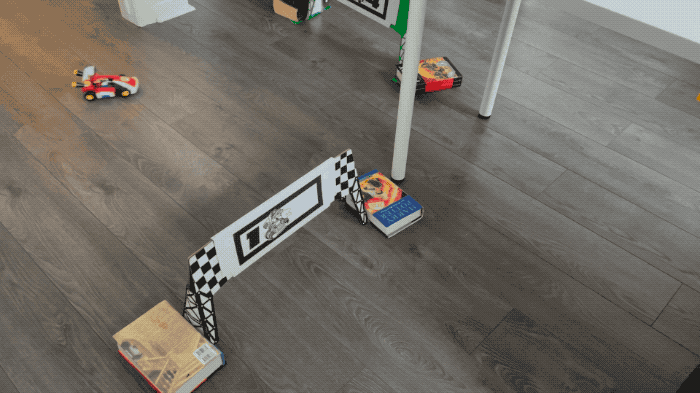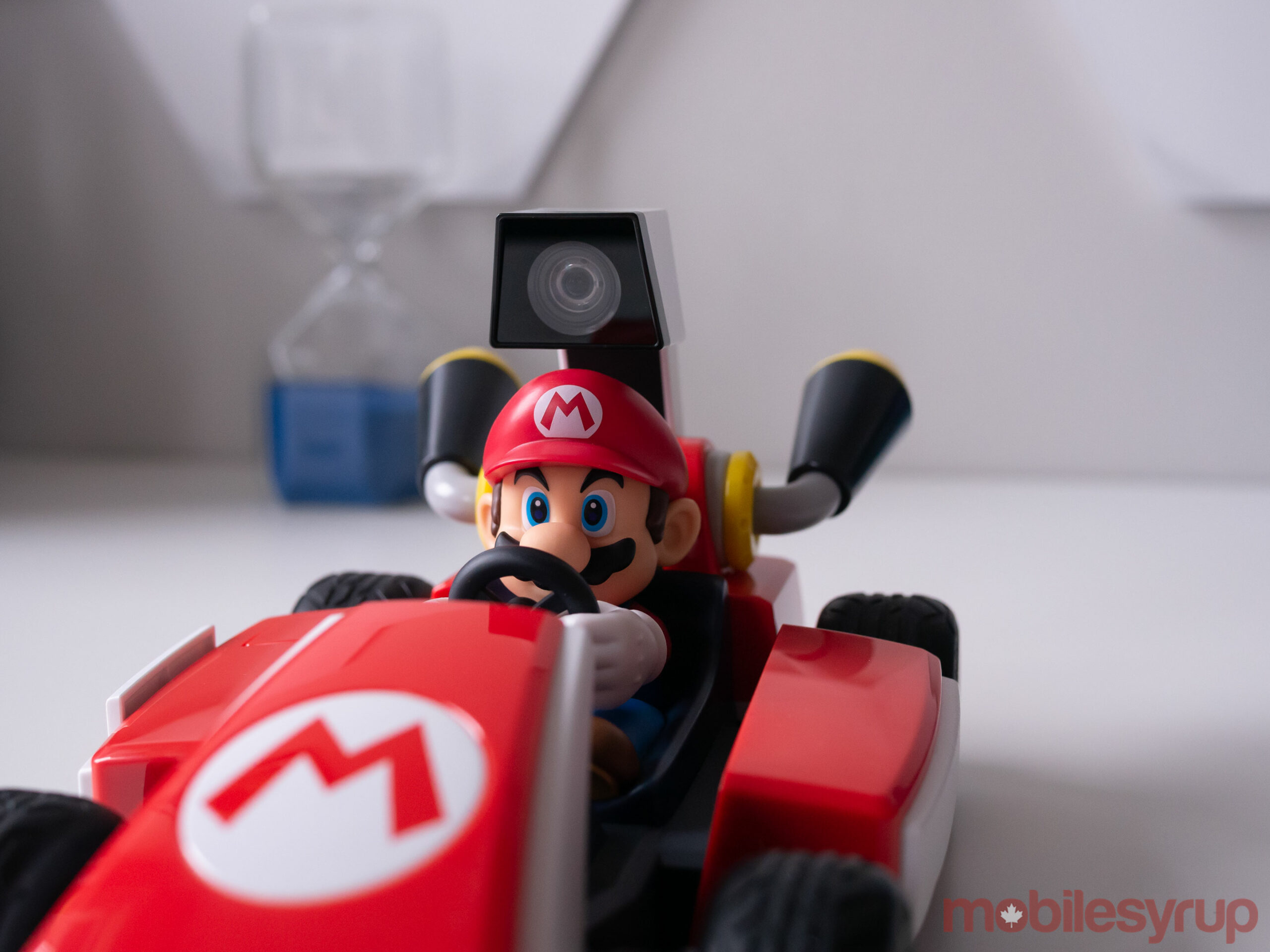
The first video game that was ever truly mine was 1992’s Micro Machines for the Nintendo Entertainment System (NES).
In Micro Machines, players race miniature toy cars around real-world tracks like a Cheerio-covered table, complete with spilled orange juice, honey and various breakfast food debris. Other tracks include a pool table, a sandbox and a backyard. Since then, there have been several other entries in the Micro Machines series, but none have been able to capture the magic of the original title’s groundbreaking top-down racing gameplay.

In several ways, Nintendo and Velan Studios’ Mario Kart Live: Home Circuit is a modern, heavily customizable augmented reality (AR) take on the Micro Machine‘s formula. The game combines classic Mario Kart gameplay with augmented reality opponents, power-ups and a real-life miniature RC kart you drive around your home on a track you create.
When you finally get the perfect track setup, the experience is spectacular, but multiplayer is unfortunately expensive since it requires two $129 physical Home Circuit karts and two Switches. Also, while Home Circuit is a Mario Kart game, it doesn’t offer enough to keep hardcore fans of the long-running kart series interested. Unlike every Mario Kart game so far, nearly all of Mario Kart Live‘s fun comes from experimenting and building tracks rather than actually racing.

First, you need to download the Home Circuit game from the eShop. Once that’s complete, you’re ready to start setting up your real-world track.
Along with the physical Mario or Luigi kart (there are separate sets for each), you also get four cardboard gates to build your track with. The gates bend and pull together quickly, but are made of cardboard, so I’m a little concerned about how long they’ll last in the long term, though they do fold up nicely again for storage. The gates are numbered and need to be placed in a specific order to create a track.
I’m not great at this game but it’s still incredibly cool. pic.twitter.com/TEdzWz4LFc
— Patrick O’Rourke (@Patrick_ORourke) October 25, 2020
When your masterpiece of a circuit is ready to go, you then drive the RC kart via the Nintendo Switch and ‘paint’ it, solidifying the design. What’s unique about Home Circuit when compared to similar toys like Anki Overdrive is that races happen in two locations: on your Switch’s screen and in real-life, dividing your attention at all times.
Connecting to the kart is a simple process. You launch Mario Kart Live on your Switch and use the physical kart’s camera to snap a picture of a QR code on the handheld. 
I spent a lot of time experimenting with my first track. At first, I started with a simple figure-eight under the multiple desks in my office, but I quickly expanded to a straightaway down the hall and into the bedroom.
However, this is where the physical kart’s turning radius started to cause issues. Sometimes I was able to make the hairpin corner I created, and in other cases, especially if I hit an AR boost mushroom, I would smash into the wall of a conveniently placed Harry Potter book (you’ll see this in the video above). I tried a setup involving a detour into my bathroom that resulted in similar turning issues.

Finally, on the suggestion of my partner, I extended the track to go under my bedroom laundry bin, dresser and then back out the other side, giving the kart ample room to make the corner. I eventually started getting more creative with my tracks, too.
I placed Amiibo as obstacles, a Master Chief on a skateboard, weighted down each gate with a book because I found myself hitting them often and added the NES Lego setup. Amiibo quickly scattered to the middle of the course as I repeatedly bumped into them, adding another variable to the race, and sometimes, my curious cat would even get in on the fun and stand in the middle of an ongoing circuit, keeping a watchful eye over the RC Mario kart and adding yet another obstacle.

The game itself looks fine on the Switch but the low-resolution camera on the physical kart can be a little fuzzy and sometimes gets confused if there’s not a lot of light in the room. For example, when driving under my dresser I found the game would sometimes skip a few frames. Further, because my final track design ended up being long, I needed to sit on the stairs near the middle of my circuit to maintain a consistent signal with the Switch and the Home Circuit kart.
The possibilities feel endless when it comes to the different ways you can set up your track. I even stumbled across a video of someone that built a Home Circuit circuit using magnetic Anki Overdrive track pieces, adding height and other factors to races.
While you don’t need a ton of space to play Home Circuit, tile, laminate or hardwood floor is a must since the surprisingly durable kart can’t navigate well on deep carpet. Also, the kart picks up debris easily. I have pretty clean floors and after an hour of racing, I needed to remove dust and stray hair from the physical kart’s wheels to keep it running smoothly.

Different visual themes impact gameplay in unique ways, including a desert with wind that pushes your kart across the track, one full of warp pipes that drop Question Mark Boxes at gates and even a spooky setting filled with Boos blocking your view.
You can also change your kart and Mario’s attire. For example, I spent one race as a space Mario in a traditional Mario kart with a massive exhaust. These different customization options are unlocked by collecting coins and playing the game’s classic three-race Grand Prix mode. Since you put together the track yourself, you can make these AR-filled circuits as easy or as difficult as you’d like. You can even tweak tracks in the middle of an ongoing circuit, which is surprising and works quite well.

Karts come in 50cc, 100cc and 150cc variants. I found 50cc and 150cc are more fun since they allow you to create complicated courses with twists, turns and several obstacles and still be able to control your kart reasonably well. Things can get a little out of control when racing at 150cc, however. There’s also a faster 200cc unlockable mode I haven’t tested out yet where carts can hit speeds of 10km/h with boosts.
In general, the physical kart controls surprisingly well, though your perspective is lower to the ground than in a traditional Mario Kart game. It’s important to note that while you can still drift around corners in-game for a speed boost, it usually results in an unintended accident. As a result, I found drifting was something I typically avoided.

I think multiplayer would likely add far more appeal to Mario Kart Live: Home Circuit, but unfortunately, Nintendo only sent me one kart and picking up an additional starter kit is expensive. Your AI opponents are Bowser Jr. and other Koopalings. While they make worthwhile foes and are usually smart enough to follow your homemade tracks, I’ve experienced instances where it feels like they’re cheating. For example, instead of actually turning a sharp corner I created, they just sort of started driving in the other direction automatically. You also drive through other racers so bumping them off the track or into obstacles is not an option.
When Mario Kart Live: Home Circuit works, it truly feels like magic, but sometimes, it takes more work than expected to get that perfect circuit. That said, my childhood dream of creating a video game race track for a miniature car is finally fulfilled.
Hopefully, in the future, Nintendo releases a two-kart bundle because multiplayer would definitely make Home Circuit far more entertaining.
MobileSyrup may earn a commission from purchases made via our links, which helps fund the journalism we provide free on our website. These links do not influence our editorial content. Support us here.


